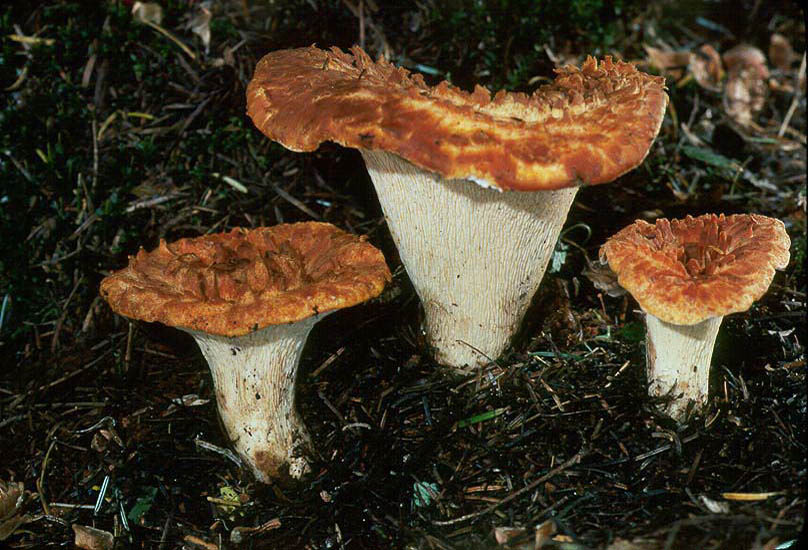
© Michael Beug
Danny’s DNA Discoveries – Gomphus and
Turbinellus of the PNW
by Danny Miller
Click here for my Pictorial Key to Gomphus and Turbinellus.
|
|
Danny’s DNA Discoveries – Gomphus and
Turbinellus of the PNW
Click here for my Pictorial Key to Gomphus and Turbinellus. |
|
Introduction
Gomphus and Turbinellus - false chanterelles with a veined stem (a busier pattern than the parallel ridges of true chanterelles). Gautieria, Protogautieria and Destuntzia - false truffles with a thin skin that wears away allowing you to see into some of the hollow chambers inside. The texture is enough like rubber that some fresh specimens might even bounce. Ramaria - corals covered on their own page. Unfortunately Ramaria subgenus Ramaria and Ramaria subgenus Laeticolor are in one big clade with Gomphus, Turbinellus, and Gautieria, etc. This means that either false chanterelles and corals will all be in one large genus Gomphus (the oldest name), or Ramaria subgenus Laeticolor may have to be split into a bunch of cryptic genera (my first guess is 9 genera)! Neither is an ideal solution. It is fascinating to have learned that false chanterelles and corals evolved back and forth so many times. I can't figure out how. It's easier to see how gilled and pored mushrooms evolved back and forth, you can picture pores as gills that are pinched together every once in a while to form the pores. But I cannot fathom why the two very different shapes of Gomphus/Turbinellus and Ramaria evolved back and forth so many times. See this tree. abundant common uncommon rare - colour codes match my Pictorial Key and are my opinions and probably reflect my bias of living in W WA. Rare species may be locally common in certain places at certain times. |
|
Summary of Interesting Results
Here are some of the newest, most interesting results of the study:
|
|
Gautieria, Protogautieria and
Destuntzia These are the false truffles from this family. Gautieria have thin skin that wears away allowing you to see into some of the hollow chambers inside. The texture is enough like rubber that some fresh specimens might even bounce. Some are odorless but some smell somewhat nauseating. More details about these will come later.
Gomphus and Turbinellus False chanterelles with a veined stem (a busier pattern than the parallel ridges of true chanterelles).
Gomphus PNW01 - has a purple stem with a more drab, smooth cap. Our species is about 3% different in ITS from EU sequences, so it might need a new name. Cantharellus brevipes is an east coast species thought to be synonymous, but we need east coast sequences to see if ours is the same as theirs and can share a new name. Gomphus brevipes is available as a name, if so. Whatever it is, this seems to be the coastal species out west. Gomphus PNW02 - one eastern WA sequence was unique and probably represents a previously unknown second species in the group. This is the interior species out west. Alaska may have a third. Gomphus PNW01 © Alan Rockefeller (from CA), G. PNW02 © Kaitlyn Labertew
Turbinellus cf floccosus PA - orange, with a indented cap with flattened scales. The orange may fade to brown. We have many local sequences, but no east coast sequences to show that we have the real species here. India and Myanmar and even Arizona seem to have sister species so I'd like to rule out that we have a sister species too. 'Gomphus' bonarii CA - this similar southern species is smaller, clustered, paler (yellow on the stem), with more erect scales and often partially buried. One WA collection probably shows us what the sequence looks like. Alternatively, this could be 'Cantharellus' floccosus var. wilsonii CA or one of the many other varieties and forms of T. floccosus. We have no idea which, if any, are genetically distinct. Turbinellus 'floccosus CA01' - from ID, CA, and AZ. This orange species has few, erect scales like G. bonarii, but without the yellow on the stem. Turbinellus kauffmanii WA - this local species has dull brown colours even when fresh (never orange nor yellow), and thicker, more erect scales like G. bonarii. However, 2 species that resemble it exist here, and I don't know which one this is and which needs its own name. Keep reading. Turbinellus PNW02 - one possible candidate for T. kauffmanii. It was found in BC and WA. Turbinellus CA01 - another possible candidate for T. kauffmanii. It was found in BC and CA. Turbinellus cf floccosus © Steve Trudell, 'Gomphus' bonarii © Shannon Adams, Turbinellus 'floccosus CA01' © Ed Barge, Turbinellus kauffmanii group member © Steve Trudell |